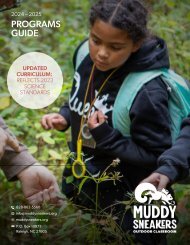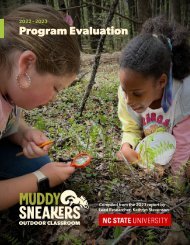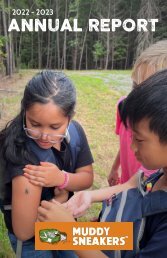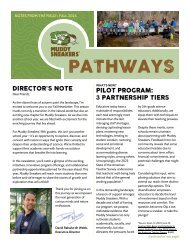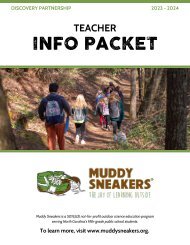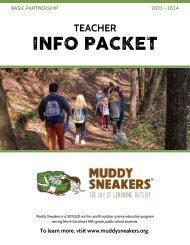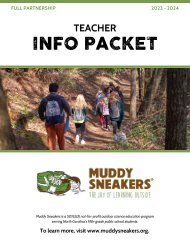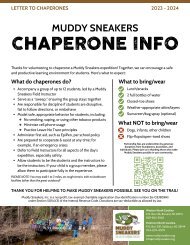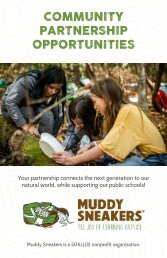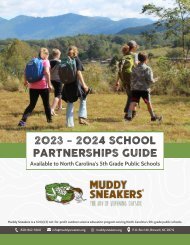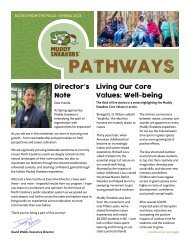2023 - 2024 Muddy Sneakers LIVE! Online Virtual Programs Guide
Muddy Sneakers LIVE! Online programs are interactive, STEM-learning adventures that bring science into your classroom and transports your students to outdoor spaces near and far! A Muddy Sneakers Instructor will guide your group in real time through innovative online lessons and hands-on classroom activities, all while meeting the NC Essential Standards for Science.
Muddy Sneakers LIVE! Online programs are interactive, STEM-learning adventures that bring science into your classroom and transports your students to outdoor spaces near and far! A Muddy Sneakers Instructor will guide your group in real time through innovative online lessons and hands-on classroom activities, all while meeting the NC Essential Standards for Science.
Create successful ePaper yourself
Turn your PDF publications into a flip-book with our unique Google optimized e-Paper software.
VIRTUAL PROGRAMS GUIDE <strong>2023</strong> - <strong>2024</strong><br />
MUDDY SNEAKERS<br />
<strong>LIVE</strong>! ONLINE<br />
<strong>Muddy</strong> <strong>Sneakers</strong> is a 501(c)(3) not-for-profit outdoor science education program<br />
serving North Carolina’s fifth-grade public school students.<br />
To learn more, visit www.muddysneakers.org.
VIRTUAL PROGRAMS GUIDE OVERVIEW<br />
3<br />
4<br />
5<br />
6<br />
CONTENTS<br />
FORCES & MOTION<br />
Forces of Nature<br />
The Newton Challenge<br />
INHERITANCE &<br />
ADAPTATION<br />
Turtle Quest<br />
Red-Tailed Hawk Family Tree<br />
BIOMES & ECOSYSTEM<br />
RELATIONSHIPS<br />
Oceans Away<br />
Buzzing Numbers<br />
<strong>Virtual</strong> Aquatics Study<br />
8 MATTER<br />
Detail Detective<br />
Matter Mysteries<br />
9<br />
TERRESTRIAL<br />
ECOSYSTEMS<br />
<strong>Virtual</strong> Log Study<br />
Terrestrial Trails<br />
LIVING SYSTEMS<br />
Heart of a Whale<br />
Super Special Systems<br />
10 WEATHER<br />
Density Experiment<br />
Weather Wise<br />
11 ENERGY<br />
Test Your Nest<br />
Amazing Amphibians<br />
12<br />
PREPARING FOR YOUR<br />
VIRTUAL SESSION<br />
What is <strong>Muddy</strong> <strong>Sneakers</strong> <strong>LIVE</strong>! <strong>Online</strong>?<br />
<strong>Muddy</strong> <strong>Sneakers</strong> <strong>LIVE</strong>! <strong>Online</strong> virtual sessions<br />
are hour-long, interactive sessions facilitated<br />
by a <strong>Muddy</strong> <strong>Sneakers</strong> Instructor.<br />
What's in this guide?<br />
This guide provides an overview of each virtual<br />
program available. For each topic, you'll find<br />
information about Session Choices, including:<br />
Description<br />
NC Standards Met & Supported<br />
Materials Needed*<br />
How to use this guide:<br />
Each <strong>Muddy</strong> <strong>Sneakers</strong> partnership includes a<br />
predetermined number of <strong>Muddy</strong> <strong>Sneakers</strong><br />
<strong>LIVE</strong>! <strong>Online</strong> virtual sessions.**<br />
At the beginning of your partnership, your<br />
school's Lead Teacher will schedule sessions<br />
for each participating class. Use this guide to<br />
select the session(s) you'd like to join.<br />
<strong>Virtual</strong> programs are always being<br />
added! To see what's in store for<br />
the future, visit our website at<br />
muddysneakers.org.<br />
*Links to materials are provided to your Lead<br />
Teacher at the beginning of the school year.<br />
**Sessions can be added for an additional fee.
FORCES & MOTION<br />
OPTION 1<br />
FORCES OF NATURE<br />
Students explore Newton’s second law of<br />
motion (F=ma) by observing ballooning spiders.<br />
Then, they virtually travel to a lake and a river<br />
habitat to find examples of forces and motion,<br />
calculate speed, and explore motion graphs.<br />
materials needed:<br />
STUDENTS:<br />
Student sheet<br />
Writing utensil<br />
standards<br />
MEETS:<br />
Science: 5.P.1.1, 5.P.1.2,<br />
5.P.1.3, 5.P.1.4<br />
SUPPORTS:<br />
Math: NC.5.NBT.3,<br />
NC.5.MD.1, NC.5.MD.2,<br />
NC.5.NF.3<br />
ELA: W5.3, W.5.6, SL5.1<br />
Art: 5.V.2.2, 5.CX.2.2<br />
OPTION 2<br />
THE NEWTON CHALLENGE<br />
Working in small teams, students are tasked<br />
to complete a series of challenges related to<br />
force, motion, friction, speed, gravity and<br />
motion graphs.<br />
materials needed:<br />
STUDENTS:<br />
Student sheet<br />
Writing utensil<br />
standards<br />
MEETS:<br />
Science: 5.P.1.1, 5.P.1.2,<br />
5.P.1.3, 5.P.1.4<br />
SUPPORTS:<br />
Math: NC.5.NBT.3,<br />
NC.5.MD.1, NC.5.MD.2,<br />
NC.5.NF.3<br />
ELA: W5.3, W.5.6, SL5.1<br />
Art: 5.V.2.2, 5.CX.2.2<br />
3
INHERITANCE & ADAPTATION<br />
OPTION 1<br />
TURTLE QUEST<br />
Students embark on a quest to explore life as an<br />
eastern box turtle. They design box turtle<br />
characters by choosing inherited and acquired<br />
traits, then join an adventure full of obstacles<br />
where the outcome depends on their traits.<br />
materials needed:<br />
STUDENTS:<br />
Student sheet<br />
Writing utensil<br />
standards<br />
MEETS:<br />
Science: Science: 5.L.3.1,<br />
5.L.3.2<br />
SUPPORTS:<br />
Math: NC.5.NF.3<br />
ELA: W5.3, W.5.6, SL5.1<br />
Art: 5.V.2.2, 5.CX.2.2<br />
OPTION 2<br />
RED-TAILED HAWK FAMILY TREE<br />
Students observe traits of a red-tailed hawk.<br />
Students listen to a story, read by a red-tailed<br />
hawk, while creating the hawks family tree.<br />
Students are tasked with solving what traits the<br />
hawks siblings could have based on the previous<br />
generation. Students explore the concepts of<br />
inherited traits versus acquired traits.<br />
4<br />
materials needed:<br />
STUDENTS:<br />
Student sheet<br />
Writing utensil<br />
standards<br />
MEETS:<br />
Science: 5.L.3.1, 5.L.3.2<br />
SUPPORTS:<br />
ELA: W.5.6, SL5.1<br />
Art: 5.V.2.2, 5.CX.2.2
TERRESTRIAL ECOSYSTEMS<br />
OPTION 1<br />
VIRTUAL LOG STUDY<br />
Students virtually explore a decomposing log<br />
ecosystem. Students practice categorizing<br />
discoveries as biotic, abiotic, producers,<br />
consumers, and decomposers. Students connect<br />
those terms to food chains and the energy<br />
pyramid.<br />
materials needed:<br />
STUDENTS:<br />
Student sheet<br />
Writing utensil<br />
standards<br />
MEETS:<br />
Science: 5.L.2.2, 5.L.2.3<br />
SUPPORTS:<br />
Science: 5.L.2.1<br />
Math: NC.5.NBT.1,<br />
NC.5.NBT.3<br />
ELA: W.5.6, SL5.1<br />
Art: 5.V.2.2, 5.CX.2.2<br />
OPTION 2<br />
TERRESTRIAL TRAILS<br />
Students take a virtual hike to identify abiotic<br />
factors, producers, consumers and<br />
decomposers. They use that information to<br />
model another hike in the classroom, working in<br />
small groups to find organisms (using the printed<br />
organism cards), categorize them as producers,<br />
consumers or decomposers, and discuss where<br />
they fit in a food chain and energy pyramid.<br />
materials needed:<br />
STUDENTS:<br />
Student sheet<br />
Writing utensil<br />
CLASS:<br />
One set of organism cards<br />
(color copy if possible)<br />
standards<br />
MEETS:<br />
Science: 5.L.2.2, 5.L.2.3<br />
SUPPORTS:<br />
Math: NC.5.NBT.1,<br />
NC.5.NBT.3<br />
ELA: W.5.6, SL5.1<br />
Art: 5.V.2.2, 5.CX.2.2<br />
5
BIOMES & ECOSYSTEM RELATIONSHIPS<br />
OPTION 1<br />
OCEANS AWAY<br />
Students draw and label parts of an aquatic<br />
ecosystem they have visited, then travel virtually<br />
to three different aquatic ecosystems (in the<br />
Atlantic Ocean, Pacific Ocean, & Gulf of Mexico),<br />
watching videos and exploring the concepts of<br />
predator/prey, survival, and interconnectedness.<br />
materials needed:<br />
STUDENTS:<br />
Student sheet<br />
Writing utensil<br />
standards<br />
MEETS:<br />
Science: 5.L.2.1, 5.L.2.2,<br />
5.L.2.3<br />
SUPPORTS:<br />
Math: NC.5.NBT.7<br />
ELA: W.5.6, SL5.1<br />
Art: 5.V.2.2, 5.CX.2.2<br />
OPTION 2<br />
VIRTUAL AQUATICS STUDY<br />
Students explore two NC aquatic ecosystems<br />
and determine the water quality of each based<br />
on the organisms discovered. Students explore<br />
the interactions between organisms found in<br />
both aquatic environments.<br />
materials needed:<br />
STUDENTS:<br />
Student sheet<br />
Writing utensil<br />
standards<br />
MEETS:<br />
Science: 5.L.2.1, 5.L.2.2,<br />
5.L.2.3<br />
SUPPORTS:<br />
ELA: W.5.6, SL5.1<br />
Art: 5.V.2.2, 5.CX.2.2<br />
6
BIOMES & ECOSYSTEM RELATIONSHIPS<br />
OPTION 3<br />
BUZZING NUMBERS<br />
Students role play as farmers. Students will<br />
choose plants to grow and calculate how many<br />
bee hives are needed to pollinate the plants. As<br />
farmers, students will face obstacles to their<br />
farm and need to adjust for losses from the<br />
obstacles. Students explore the ecosystem<br />
relationships involved with farming (pollination,<br />
predators, pests). This is a math-heavy activity.<br />
materials needed:<br />
STUDENTS:<br />
Student sheet<br />
Writing utensil<br />
standards<br />
MEETS:<br />
Science: 5.L.2.3<br />
Math: NC.5.NBT.5<br />
SUPPORTS:<br />
Math: NC.5.NBT.7<br />
ELA: W.5.6, SL5.1<br />
*This activity requires more than one class period of work and a<br />
teacher/<strong>Muddy</strong> <strong>Sneakers</strong> check-in a week prior to set up.<br />
7
MATTER<br />
OPTION 1<br />
DETAIL DETECTIVE<br />
Students find evidence of the water cycle by<br />
observing a video clip of the Great Smoky<br />
Mountains. Then, they examine a small natural<br />
object to record observations, collect data and<br />
explore chemical and physical changes.<br />
materials needed:<br />
STUDENTS:<br />
Student sheet<br />
Writing utensil<br />
Small natural object<br />
standards<br />
MEETS:<br />
Science: 5.P.2.1, 5.P.2.2,<br />
5.P.2.3<br />
SUPPORTS:<br />
Math: NC.5.MD.1, NC.5.NBT.6<br />
ELA: W.5.6, SL5.1<br />
Art: 5.V.2.2, 5.CX.2.2<br />
OPTION 2<br />
MATTER MYSTERIES<br />
Students are tasked with solving a mystery.<br />
Students listen to a story narrated by an<br />
organism that lives in North Carolina. They will<br />
collect clues to determine what type of<br />
organism is telling the story while exploring the<br />
water cycle, chemical changes, and physical<br />
changes.<br />
8<br />
materials needed:<br />
STUDENTS:<br />
Student sheet<br />
Writing utensil<br />
standards<br />
MEETS:<br />
Science: 5.P.2.1, 5.P.2.3<br />
SUPPORTS:<br />
ELA: W.5.6, SL5.1<br />
Art: 5.V.2.2, 5.CX.2.2
LIVING SYSTEMS<br />
OPTION 1<br />
HEART OF A WHALE<br />
Students conduct experiments testing changes<br />
in their pulse while performing different physical<br />
exercises beside their desks. They explore the<br />
relationship between their cardiovascular and<br />
respiratory systems, then compare human heart<br />
rate and size with those of other organisms.<br />
materials needed:<br />
STUDENTS:<br />
Student sheet<br />
Writing utensil<br />
standards<br />
MEETS:<br />
Science: 5.L.1.2<br />
SUPPORTS:<br />
Math: NC.5.G.1, NC.5.MD.2<br />
ELA: W.5.6, SL5.1<br />
OPTION 2<br />
SUPER SPECIAL SYSTEMS<br />
Students explore the six body systems by<br />
comparing other organisms' structure and<br />
function to humans. Students make<br />
observations, draw pictures and have discussions<br />
about all of the body systems.<br />
standards<br />
MEETS:<br />
Science: 5.L.1.2<br />
materials needed:<br />
STUDENTS:<br />
Student sheet<br />
Writing utensil<br />
SUPPORTS:<br />
ELA: W.5.6, SL5.1<br />
Art: 5.V.2.2, 5.CX.2.2<br />
9
WEATHER<br />
OPTION 1<br />
DENSITY EXPERIMENT<br />
In small groups, students conduct an experiment<br />
demonstrating the concept of density. They<br />
hypothesize what will happen when water and<br />
oil mix, and make connections between density,<br />
fronts, weather patterns and weather maps.<br />
materials needed:<br />
STUDENTS:<br />
Student sheet<br />
Writing utensil<br />
EACH GROUP OF 2 - 4 STUDENTS:<br />
standards<br />
MEETS:<br />
Science: 5.E.1.3<br />
SUPPORTS:<br />
Art: 5.V.2.2, 5.CX.2.2<br />
ELA: W.5.6, SL5.1<br />
Clear jar/cup of water (1 drop of food coloring optional)<br />
¼ - ⅓ cup of vegetable oil<br />
3 - 5 small natural items to test density<br />
OPTION 2<br />
WEATHER WISE<br />
Students explore three topics (wind, clouds and<br />
severe weather). Students guide the learning by<br />
choosing which topics and questions to answer<br />
first. Students then explore weather instruments<br />
and how cricket songs can help estimate the<br />
temperature of their environment.<br />
materials needed:<br />
STUDENTS:<br />
Student sheet<br />
Writing utensil<br />
standards<br />
MEETS:<br />
Science: 5.E.1.1, 5.E.1.2, 5.E.1.3<br />
SUPPORTS:<br />
ELA: W.5.6, SL5.1<br />
Math: NC.5.MD.2, NC5.NBT.6<br />
10
ENERGY<br />
OPTION 1<br />
TEST YOUR NEST<br />
In small groups, students explore the three<br />
methods of heat transfer, conductors, and<br />
insulators while building a nest. They run an<br />
experiment to explore how nest design and<br />
materials can impact the way heat is transferred<br />
to an ice cube.<br />
materials needed:<br />
STUDENTS:<br />
Student sheet<br />
Writing utensil<br />
EACH GROUP OF 2 - 4 STUDENTS:<br />
standards<br />
MEETS:<br />
Science: 5.P.3.1, 5.P.3.2<br />
SUPPORTS:<br />
Nest building materials (cloth, sticks, leaves, bowl etc)<br />
Math: NC.5.MD.2, NC.5.G.1<br />
ELA: W.5.6, SL5.1<br />
Art: 5.V.2.2, 5.CX.2.2<br />
2 ice cubes, each cube in a zip lock bag (1 cube per bag)<br />
OPTION 2<br />
AMAZING AMPHIBIANS<br />
Students learn about a local amphibian (either a<br />
waterdog or hellbender, depending upon the<br />
school's location). Students explore the<br />
concepts of heat transfer as it relates to lakes<br />
and rivers, in addition to other examples of heat<br />
transfer in nature like nests and reptiles sunning.<br />
materials needed:<br />
STUDENTS:<br />
Student Writing utensil sheet<br />
standards<br />
MEETS:<br />
Science: 5.P.3.1, 5.P.3.2<br />
SUPPORTS:<br />
ELA: W.5.6, SL5.1<br />
Art: 5.V.2.2, 5.CX.2.2<br />
11
PREPARING FOR VIRTUAL SESSIONS<br />
TEACHER CHECKLIST:<br />
Tech Help:<br />
Confirm logistics, including dates, times, and links.<br />
Set up classroom technology for a <strong>Muddy</strong> <strong>Sneakers</strong> Instructor to join class virtually (either<br />
projecting the session from teacher computer onto a large screen, or connecting students<br />
on individual devices).<br />
Supply appropriate materials & links to any students joining the classroom virtually .<br />
Print out or gather required session materials for students .<br />
Ensure at least one classroom teacher/chaperone is present during sessions.<br />
An optional tech check is available at the beginning of the year to ensure you and your team<br />
are comfortable using the technology selected.<br />
If technology is a challenge for your school, contact us to discuss options!<br />
Partnership fees are underwritten by generous donations from<br />
foundations, businesses, and individuals. Please join us in thanking<br />
those who make <strong>Muddy</strong> <strong>Sneakers</strong> possible in your community.<br />
<strong>Muddy</strong> <strong>Sneakers</strong>, Inc. is a nonprofit, tax-exempt charitable organization (tax identification<br />
number 26-0338084) under Section 501(c)(3) of the Internal Revenue Code. Donations<br />
are tax-deductible as allowed by law.<br />
www.muddysneakers.org




